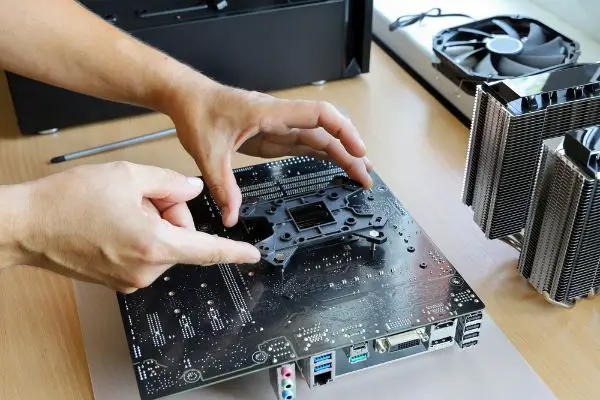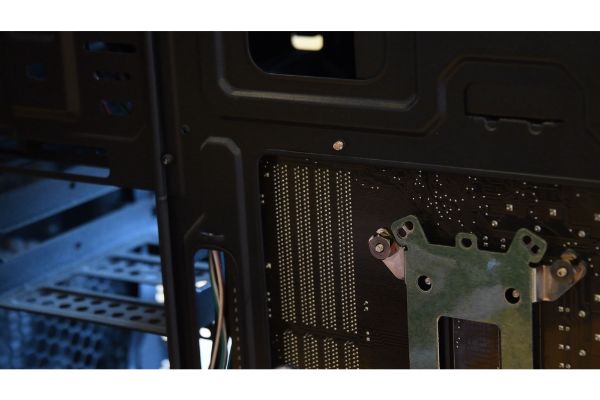Disclaimer: This post may contain affiliate links, meaning we get a small commission if you make a purchase through our links, at no cost to you. For more information, please visit our Disclaimer Page.
Your computer is filled with circuits, and many of those circuits are attached to boards that allow the system to keep them ordered and send data through them. The motherboard is the main one of this type in most laptops or desktops meant for general use by everyday users.
You can think of it as the nervous system of the computer. It gets instructions from the central processor, and it transmits data to other parts of the computer so that the machine can execute tasks you need it to do. Essentially, it fosters communication between the different components and hardware inside your rig.
Many manufacturers install backplates on the motherboards they produce, and some users may wonder just what this plate is and how it functions. We’ll touch on the main purposes of backplates in motherboards, and we’ll take you through the differences you might find in some of these plates when you compare different motherboard models.
Further, we can discuss whether backplates are always a necessary part of a motherboard’s architecture, whether all motherboards have backplates included when you buy them, and when you might wish to remove the plates entirely.
Table of Contents
What Is a Backplate for on a Motherboard?
If you were to take your rig apart so that you could look at the motherboard, you would notice that the front and back have different sockets or connectors. On the front of the motherboard, there is a socket or bracket that is for keeping the central processor in place.
Some hobbyists may also refer to this as the CPU retention bracket. If you flip the motherboard over, there is a similar plate on the backside. This is your motherboard’s backplate.
The backplate serves two primary functions. Firstly, it has settings for screws. You can use these settings to screw the CPU cooler to that side of the motherboard. Secondly, it helps to transfer the heat on the front side of the motherboard to its back.
This process helps the cooler deal with excess heat buildup from the central processor itself. Because CPU coolers are such a necessary component of any good computer setup, backplates for the motherboard are crucial accessories, too.
The backplate should look like a thin strip of metal roughly in the shape of an X. Your motherboard should have one attached already, but we will also cover scenarios where this may not be the case. If not, there are contingencies at your disposal to ensure you can attach your system’s cooler properly.
All backplates should be snug against the rear side of the motherboard. It is possible that your case model features cutouts that can help to guide you along the appropriate path for positioning the backplate.
Are All Motherboard Backplates the Same?
In most respects, yes, all motherboard backplates are the same. As we touched on, they are just strips of metal that serve as mounting points for the CPU cooler.
It is possible that you might find a backplate that is not standard, but this would be the case only if you’re dealing with a custom setup. If you are working with retail parts, backplates should be standardized to fit into retail cases.
If you are getting a new motherboard for your current case, you might be concerned about the backplate. However, all you need to do is look at how the current motherboard fits your case. If it comes with its own backplate and fits within the system without any problems, you should be good to go.
Your new motherboard and its accompanying backplate should both be able to fit inside the case properly without any issues. If you did not install your current motherboard, you could follow the instructions on your new one for the best results. CPU coolers should also come with similar instructions for mounting on a backplate.
Do I Need a Motherboard Backplate?
Whether you need a backplate for your motherboard depends on what type of board or CPU cooler you have. If you are upgrading your processor’s cooler and don’t have any kind of backplate on your motherboard, you may need one for safety.
If you find that you lack such a plate, it is possible that the new cooler you purchase will have one of its own. If it does, be sure to follow the instructions for installing the cooler in the correct spot.
If you notice that your motherboard has a backplate, it is because the manufacturer deemed it a necessary feature to accommodate whatever stock cooler your rig is using.
However, depending on the type of cooler ad its weight and configuration, you may not need the backplate for things to work well. We touched on some of the primary purposes of the backplate earlier, but it can have a third job dependent on the model of cooler you choose.
The backplate provides a dedicated space to help you install and secure the cooler in its proper position. It acts as a guideline, but it also helps to ensure that you don’t bend or crack the motherboard when you are putting the cooler in your system.
This is particularly true when it comes to heavier coolers. Often, they will rely on the backplate to provide a secure mounting area, but such a plate would also serve as a barrier between the accessory and the motherboard.
Due to the way it mounts inside a rig, the plate helps to distribute the weight of a cooler accessory and keeps it from overwhelming the relatively light and thin motherboard.
Should You Remove Motherboard Backplates?
Generally, it should not be necessary to remove motherboard backplates. They are there to help the cooler, and they also protect parts of the board itself. The only scenario in which you might need to remove such plates is if, for whatever reason, the cooler you want to use is not compatible with the plate on the back of the board.
As we mentioned, this should be a rare occurrence. If you do need to remove the backplate for this reason, we recommend that you follow any instructions set forth by your motherboard’s manufacturer. This way, you can mitigate any risk of damaging the board itself.
Even if you have to remove the backplate, ensure that the cooler you want to install comes with one of its own plates for mounting. Although it should be compatible with the board you already have, it is best to check the specifications before you do anything else.
Just like motherboards, most coolers should come with their own instructions for proper mounting, and parts of these instructions will deal with the plate.
Do Motherboards Come With Backplates?
Many motherboards come with backplates. However, you may find some boards that do not have their own plates. This can be quite rare, and almost all boards in modern systems should have plates.
You may be dealing with an older model that doesn’t have one installed. In most cases, this is because it is assumed that whatever cooler you choose will have a plate of its own. This is where the importance of compatibility comes into play.
We mentioned that retail backplates were pretty standardized, but you could use a board that doesn’t have one. In this case, it is important to ensure that the cooler you choose includes one of its own. Because backplates are so necessary for heavier coolers or motherboard protection, most of the ones you find should have plates of their own.
It is a good idea to make sure one of these components has a backplate. There is little reason not to have one, and the possibility of damaging the board or working with a cooler that isn’t secure is too great.
If your computer tower has a cutout, it can make putting the cooler with the motherboard backplate a relatively easy. If not, it is worth it to open the rig and mount the cooler to the backplate properly.
Conclusion
Backplates are simple yet effective metallic pieces attached to the rear panel of a motherboard. You can also find similar plates on many aftermarket central processor coolers. In a minor way, the backplate can protect some of the connectors on the board from dust and debris.
However, it also keeps the motherboard safe from the cooler and helps ensure that heat gets to where the cooler can deal with it. A backplate of some type is necessary, particularly for heavier coolers, and most manufacturers of retail parts will standardize them for the user’s convenience.


